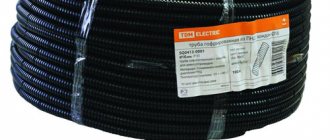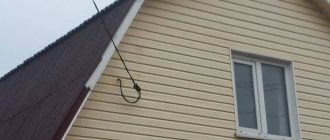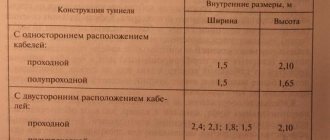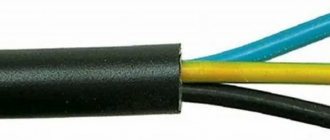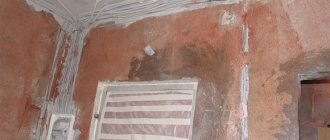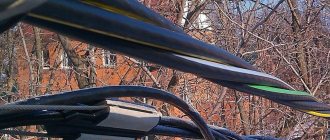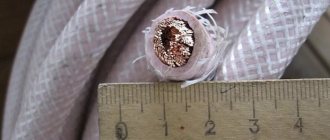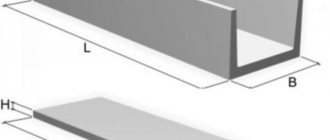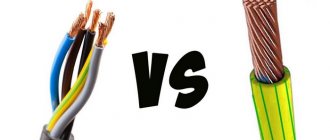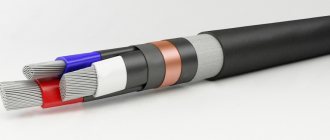Do you want to protect electrical wires by putting a corrugated sleeve on them during installation? The cable must be protected from external damage, right? But you don’t know how to properly install flexible corrugation for electrical wiring?
We will show you how to install the corrugated hose. Here you will find out what types of flexible channels are used for these purposes. The article examines their pros and cons, and highlights the intricacies of installation of existing options for electrical pipes made of different materials.
The article is equipped with thematic photos, tips on choosing corrugated hoses and video recommendations for laying wires on your own. Visual illustrations will greatly simplify installation and dismantling work.
Why do you need corrugation?
Laying electrical cables and wires in corrugated areas is recommended for various reasons:
- When laid in flammable walls (wooden or frame), behind flammable finishing (lining, PVC boards), when attached to wooden floors - for fire safety reasons. In this case, non-combustible shells are chosen.
- When laying behind finishing materials - behind lining, plasterboard, PVC boards, etc. - for security reasons. To make it more difficult to damage the cable when trying to hang something on the wall. In this case, the most important indicator is the hardness of the shell.
Corrugated pipes for electrical wiring come in different colors. It's for a reason, colors have meaning. - When laying cables in a screed or under the floor, under finishing, corrugation is used for several purposes. Firstly, to protect against compression when pouring concrete. Secondly, to be able to change the cable if it is damaged without destroying the floor. Third, to protect against damage.
- When laying externally, the sheath is needed to protect the cable from atmospheric influences (ultraviolet) and mechanical damage. When laying open through the air, a corrugation with a wide temperature range (to withstand heat and frost) and durability are required. to ultraviolet. If the cable is suspended, reinforcement is also necessary to increase the load-bearing capacity.
- When laying underground, water resistance as well as rigidity are important.
When laying rigid corrugation on turns, it is better to use special couplings
In general, corrugation, even metal, is not the best protection against mechanical destruction. You can only hope that if you feel that the drill has failed, you will be able to stop in time. And in order to definitely not get into the electrical wiring, it is better to have an exact plan for its installation with measurements and reference to the corners. After all, not every wiring detector detects a corrugated cable, even under load. So, before pouring the screed, before finishing, don’t forget to take photographs, sketches and mark distances.
Execution
The following types of corrugated pipes are manufactured for various installation and operating conditions:
- lightweight - used when installing internal wiring. This type is characterized by high flexibility, which is achieved due to its small thickness. Such pipes easily follow the contour of the room, which greatly simplifies installation. Typically installed under drywall or other sheathing;
- heavy - this type has thicker walls, which significantly increases strength. Heavy corrugation is used for laying under a cement-concrete screed, for example, on the floor or when laying a street highway in a trench laid in the ground.
To ensure that tightening the wires into the corrugation does not cause problems, it is equipped with a special probe (this is a steel wire located inside). This design greatly simplifies the cable pulling process.
Corrugation equipped with a broach (probe)
It should be noted that there are products that are not equipped with a probe. The price of such corrugation is much lower, the quality is the same, but pulling the cable into it will be problematic.
Types of corrugations for laying cables
Corrugated cables are available in different strengths:
- Easy. It has a thin wall and the highest degree of flexibility. Recommended for installation under cladding in walls and ceilings. Doesn't hold mechanical load well.
- Average. A little thicker than light, but not as stiff as heavy. Can be used in walls and screeds. They are good for walls, but it is better to lay heavy corrugation in the screed.
This is a double-walled corrugation - ribbed on the outside, smooth on the inside. It makes re-tightening the cable no problem. - Heavy. The walls are thick, flexibility is low. You can lay it in a screed or bury it in the ground. For turns, it is better to use angles or special couplings, since the minimum bending radius is quite large. They provide a normal degree of protection both in terms of moisture and dust resistance.
- Reinforced. Plastic sheaths are applied over twisted steel wire. This is the best option for laying in the ground and for hanging.
As you can see, the classification is based on strength properties, which determines the area of use.
Varieties
In addition to all this, there is also corrugation with and without broaching. A broach is a thin cable or wire that makes it easier to tighten the cable into the corrugation. The cable is tied to the end of the cable, pulled at the other end, tucking the cable inside. Without pulling it will be difficult to cope with this task - with sufficient rigidity, several meters of cable can simply be pushed inside, but if the route is long, this will be too difficult.
The cable corrugation can be with a broach (the correct name is “probe”) or without
If we talk about the types of plastic corrugation, we must mention that there is a two-layer corrugation. On the outside it has the same ribbed surface, but on the inside it is smooth. Corrugation for a cable of this type is expensive, but if necessary, you can actually stretch a new cable into it. In those events where the inner wall is ribbed, this is not always possible - if the track has a minimum of turns, and even those over a wide radius.
Metal and metal-polymer corrugation
Metal corrugation for cables also varies. It is made of galvanized or stainless steel. In addition, there is a metal corrugation with a polymer coating. It has the best characteristics for protection against dust and moisture. This protective shell is also called metal-polymer.
Replaceability of electrical wiring
Imagine that you needed to hang one or more paintings on the wall a few years after the renovation.
You take a hammer drill, mark the fastening points, start drilling and hear a characteristic pop with the release of a large number of sparks.
And only then do you remember about the cable going to the socket hidden behind the bedside table. It is useless to turn on the machine; there will be a stable short circuit on the line. And all the other sockets in the room can hang on this group.
If you have suspended ceilings installed, then in principle there is no question of replacing the damaged area, but under one condition - if the cable is laid in a corrugated area.
You can easily replace this piece by simply unfastening part of the ceiling, running a new cable and zipping it back up. At the same time, there is no chiselling or breaking into walls.
So that you understand, if someone talks about the replacement of wiring in a corrugated cable, we are primarily talking about vertical sections from the ceiling to the sockets.
On the ceiling itself, when turning at 90 degrees, this trick is unlikely to succeed.
Imagine that with all of the above, the cable is embedded in the plaster? You can, of course, not open the walls, but simply abandon this outlet (by biting off the connection to it under the ceiling).
But then get your longest carriers and extensions ready for unsheathing.
What materials?
Corrugation for cables and electrical wires is made of plastic and metal. Different materials are used, with different characteristics. They must be selected based on the tasks they must perform.
- Polypropylene (PPR). The color of this corrugation is usually blue, the material is self-extinguishing and does not support combustion. It is characterized by increased water resistance and can be used for laying cables outdoors or in rooms with high humidity.
- PVC (polyvinyl chloride). The color is gray pipes, self-extinguishing. PVC corrugation is not waterproof and can only be used in dry rooms.
Black cable corrugation is most often made of HDPE, but it can also be made of polypropylene (PPR) - HDPE (low density polyethylene). Color - orange, black, the material is flammable, but resistant to chemical influences and water. Area of application: laying in screeds and grooves in non-combustible walls, open laying on the street.
- Metal (stainless or galvanized steel). Non-flammable material, resistant to mechanical and chemical influences. Recommended for electrical wiring in flammable buildings (wooden, frame). Also good for outdoor installations.
If we talk about compliance with fire safety standards when installing gaskets in flammable walls, the ideal option is a metal pipe. It saves you from loads that may arise when the size of the building changes. Rodents cannot cope with it either. This is also the best option from a fire safety point of view: even if short-circuit currents occur and the circuit breaker does not operate, the probability of burning through a pipe with a wall thickness of 2 mm is very small. This means the fire will not start. If laying electrical cables in pipes does not appeal to you at all, then you can use metal cable ducts or corrugated stainless steel or galvanized steel.
Advantages
The validity of the requirement for wiring in corrugated pipes is explained by their following characteristics:
- long period of operation (more than half a century), throughout the entire service life the pipes retain their properties;
- the corrugation does not allow moisture to pass through (if a special split rubber sealing gasket is installed at the joint);
- excellent flammability resistance;
- high resistance to mechanical load;
- wide operating temperature range (from -20 to 60°C);
- does not interact with chemically active substances (with the exception of metal hoses);
- not subject to oxidation (corrosion);
- the material is environmentally friendly and absolutely safe for human health;
- Light weight greatly simplifies installation and transportation.
This is interesting: Diameter and dimensions of sewer plastic pipes
Cable corrugation, sizes, prices
Corrugated pipes for electrical networks are available in sizes from 16 mm to 65 mm. When choosing a size, you need to take into account that these products have two diameters - outer and inner. If you are going to lay several conductors - wires or cables - the diameter must be selected so that there is a clearance of at least half the radius. This requirement is based on the fact that when installed in groups (it is necessary, by the way, to take a special cable), it will heat up more and the presence of an air gap will contribute to better heat dissipation.
The price of corrugated electrical pipes depends on many factors
Size selection
The choice of corrugation diameter also depends on the area where it will be laid:
- for lighting fixtures - 16 mm;
- to sockets and switches - at least 20 mm;
The size of the corrugation for the electrical cable is selected depending on the number and size of the conductors - from the main distribution box to the next box, from the shield - at least 25 mm;
- the connection between two electrical panels is at least 32 mm, and it is better to have a spare second line;
- passage through the floors with rigid corrugation of at least 40 mm in diameter;
- laying low-current cables (telephone, internet, antenna, etc.) - from 25 mm.
The diameter of the corrugation for laying the cable is selected depending on the number and cross-section of wires. Data for copper conductors are given in the table.
Table for choosing the diameter of the corrugation for cables and wires depending on the cross-section and number of wires
This information is for reference only, but you can use it as a guide. You can take a larger, but not smaller diameter.
Prices
Generally speaking, the cheapest is PVC cable corrugation, in the middle range - PP and HDPE, and the most expensive is metal corrugation. Moreover, the option with broaching is slightly more expensive than without it. When purchasing, you need to pay attention to the same wall thickness and color uniformity.
Different materials, colors, wall thicknesses and different prices
Corrugated cables are sold in coils of 50 and 100 meters, less often you can find them in meters, but the price is then a little higher. In general, the price depends not only on the material, but also on the wall thickness. The cheapest is lightweight PVC corrugated cable, but sometimes it looks more like just a film. It’s hard to say what this can protect against. If you care about quality, it is better to purchase everything related to electrical equipment not in construction supermarkets like Leroy, etc. and in specialized ones. The quality there is usually better, and the prices, if higher, are reasonable. To give you an idea of the possible price range, we will summarize several types of corrugation with brief technical characteristics in the table.
| Name | Type | External diameter | Inner diameter | Broach | Price per meter | IP | Purpose |
| PVC corrugation | light | 16 mm | 11.4 mm | Yes | 2.4 RUR | ||
| Black corrugated HDPE pipe | DKS | 15.7 mm | 11.3 mm | Yes | from 7.5 rub/m | 55 | for hidden installation |
| Black corrugated HDPE pipe | DKS | 19.5 mm | 14.5 mm | Yes | from 8.9 rub/m | 55 | for hidden wiring |
| HDPE red double-wall pipe | tough | 50 mm | 41.5 mm | Yes | 78.5 rub/m | 44 | for hidden installation |
| HDPE pipe is heavy | heavy | 31 mm | 23.4 mm | Yes | from 9.7 rub/m | 55 | hidden gasket |
| PPL (polypropylene) corrugated pipe | light | 19.7 mm | 14.8 mm | Yes | from 28 rub/m | 55 | open, hidden gasket |
| Corrugated pipe polyamide | black | 21.2 mm | 16.8 mm | No | from 52 rub/m | 68 | open, hidden gasket, UV resistant |
| Corrugated pipe polyamide | gray | 21.2 mm | 16.8 mm | Yes | from 48 rub/m | 68 | open, hidden gasket |
How to choose
Considering that various types of cable (VVGng, VVG, NUM, optical, etc.) can be installed in the corrugation, it is necessary to select its dimensions correctly. They directly depend on the diameter of the cable and their number in the corrugation. For example, for a computer network or lighting, a 16 mm pipe will be sufficient.
For outlets to sockets and switches, corrugation of 20 mm diameter is used. Power wiring is mounted in pipes from 25 to 50 mm.
We do not recommend buying a corrugated cable that is not equipped with a probe for pulling the electrical cable, despite its relatively low cost. Such a choice will be unjustified, since pulling the cable will become significantly more complicated.
It is necessary to pay attention to the technical characteristics of the products, as well as whether they have an appropriate certificate.
For convenience, the corrugation, depending on its purpose, is painted in a certain color. For this purpose, a unified European standard was adopted; the table below shows the correspondence of color to purpose.
| White | For computer networks |
| Gray | General wiring |
| Brown or black | Connecting household appliances and appliances |
| Green | Telephone wiring |
| Red | External wiring |
| Blue | For heated floors and flexible water supply pipes |
| Yellow | In gas supply systems |
Installation of corrugated pipes
For external (open) installation, special plastic clips are used to secure the corrugations for cables and wires, which are selected to match the outer diameter of the pipe. The clips are attached every 20-30 cm with self-tapping screws or dowels, depending on the type of wall. The corrugation for the kbaley is inserted into the installed clips and pressed until it clicks. When installed in a groove, it is secured with plastic ties or dowel ties. You can also use homemade fasteners - strips of tin with nails or screws in the middle.
When developing a route, the following recommendations should be taken into account. They assume that the route should be without sharp turns so that, if necessary, a new piece of cable can be tightened. Because:
- The maximum possible length of the section is 20-25 meters. Provided that the track has no more than 4 turns.
Lay the electric corrugation in parallel, trying to make as few turns as possible - Turns should not be located next to each other. The distance between them is at least 4-5 meters. If there is a need to make turns nearby, it is better to place a junction box or inspection hatch near them.
- The rotation angle is at least 90°, the radius is larger, the better.
- If the routes for electrical wiring and low-current cables and wires run side by side, the minimum distance for laying two corrugated sleeves is 200 mm. They can only intersect at right angles.
These rules apply to the development of routes for ground (suspension) and underground cable laying, among other things. If the route is long, and you want to be able to re-tighten the cable “if something happens” without replacing the corrugation, design the route taking these rules into account.
Corrugated wiring installation
When installing wiring in a house or apartment, pieces of corrugation are secured between distribution boxes, from them to switches/sockets, and to lighting fixtures. The sections here are usually small, straight, with a maximum of one or two turns. So there are no problems with cable tightening.
If you need to tighten several conductors into a cable corrugation, they are folded and secured along the entire length with adhesive tape or electrical tape in increments of 30-50 cm (depending on the rigidity). Hard insulation is stripped off 10-15 cm from one edge, the wires are twisted into a common bundle, and a loop is formed from it (also secure the loop with tape or tape). If the rope turns out to be too thick, you can form loops separately, just stretch the twine through everything. A cable is tied to this loop, and then they begin to pull it from the opposite side, pulling the sheath over the cables. In this case, you must pull without jerking, smoothly, so as not to damage the cable or cable.
How to pull a cable into a corrugation
During installation, be careful not to let the broach slip out. To be sure, you can secure the cable with a piece of tape. There are two installation approaches:
- First secure the corrugation, then tighten the cable or wires into the finished piece.
- First stretch the cable, then install it.
The first method is good when installing internal wiring, where the distances are small - from box to box, from box to outlet, etc. The second method is more suitable when installing long sections.
Features of open installation on the street
When laying wiring outdoors, it is usually suspended on a cable. For outdoor use, a metal one made of stainless steel is suitable, or better yet a metal-polymer corrugation for the cable, as well as a plastic one made of polyamide (black or blue). All these materials are UV resistant and remain flexible at sub-zero temperatures.
Although this is a cheap method, it is not the best, since the ties will burst
During installation, the cable pulled into the corrugation is suspended on a cable. The cheapest fastening is ordinary plastic ties. There are also special hangers.
Methods and rules for laying HDPE pipes
The general rules for all installation methods are as follows:
- It is not recommended to lay cables of different networks in the cavity of one protective channel.
- Do not bend the pipe at an acute angle, as this may lead to the formation of a crease.
- The joints between the pipes must be sealed. Individual products can be connected using compression couplings, press fittings or butt welding.
- The length of the section between the boxes should not exceed 25 meters.
- When laying openly outside the building, black HDPE corrugation, resistant to ultraviolet radiation, should be used.
- To ensure the drainage of condensate formed on external surfaces, the pipelines must have a slope directed towards the duct boxes. Moisture will collect in them.
- When the channel is buried more than 2 meters into the soil, it is necessary to place a protective concrete screed 8–10 cm thick on top.
Laying pipes inside buildings
Installation of cable channels inside buildings is carried out in the following order:
- Cable routing markings.
- Punching grooves in the building envelope (if necessary).
- Connecting individual HDPE pipes into a pipeline and fixing them. To fasten products to walls or ceilings, special holders with a latch are used; to the floor, metal brackets are used.
- Sealing of the structure depending on the location of the channel and its diameter. To seal the walls, use plaster or other finishing materials. Pipelines laid in the floor are poured with concrete.
- Cable pulling. The wire inside the plastic pipeline should be positioned freely, without tension.
Laying outdoors in a trench
The process of laying HDPE pipes for cables in the ground consists of the following steps:
- marking the dimensions of the trench;
- trench excavation and bottom leveling;
- laying out pipes along the trench;
- backfilling the base of the ditch with sand or soft soil 10 cm;
- sequential laying of pipe sections with sealing of joints by resistance welding;
- checking the integrity of the cable sheath and pulling it into the pipe cavity without tension;
- backfilling the finished pipeline with soft soil or sand with a layer thickness of 10–15 cm;
- backfilling the trench with soil.
So that the laid route can be found in the future, signal posts are placed above it. When installing cables underground, fittings cannot be used to connect parts of a polyethylene pipeline. They can break its tightness.
Trenchless method of laying in the ground
In cramped conditions of private courtyards or dachas, where it is not possible to dig a trench, a trenchless cable laying method is used. To do this, special equipment is used that allows you to drill the soil in a horizontal direction. Before starting work, you need to obtain a drilling permit and perform an analysis of the geological composition of the soil.
Cable laying using the trenchless method is carried out in the following sequence:
- Drilling a pilot well. It is performed using a special tip attached to a flexible rod. It allows you to change direction when encountering natural obstacles in the ground. The tip is equipped with special cooling holes and a navigation device. This allows you to control the drilling trajectory and correct its direction.
- Expansion of the well to the required size. At this stage, the tip is replaced with an expander, which makes it possible to increase the diameter of the well to the design parameters;
- Pipe laying. First, you need to insert a cable into the pipeline, and then attach the assembled structure to a special rod of the HDD installation, which will pull it through the well. To reduce the friction force when passing a line of communication through a horizontal channel, drilling fluid is used.
Design features
The design of corrugated pipes comes in two types:
- single-layer, with this option the pipe has a common wall between the inner and outer surfaces;
Single-layer corrugation
- two-layer (the inner layer is placed in a corrugation for the electrical cable, this is an ordinary smooth polymer pipe).
Two-layer (double) corrugation
Useful tips
In conclusion, here are some useful recommendations:
- Self-tapping screws on the wall should be mounted at a medium or short distance - within 40-50 centimeters. Otherwise, the corrugated pipe will begin to sag, and the structure will lose its strength and elasticity.
- If you wish, you can buy regular corrugation, and then manually stretch the wire along its length. However, such work is quite difficult to carry out - it is much easier to spend a little money and immediately buy a pipe with wire.
At the end of the article, we note that when replacing the cable, the corrugated pipe does not have to be dismantled.
To replace, you need to tie the edge of the old cable to the new wiring, and then wrap the connection with electrical tape. Then you need to grab the old cable from the other end and carefully pull it out of the pipe. As a result, you will not only pull out the old wiring, but also immediately lay a new one. Corrugation in electrical installation video
